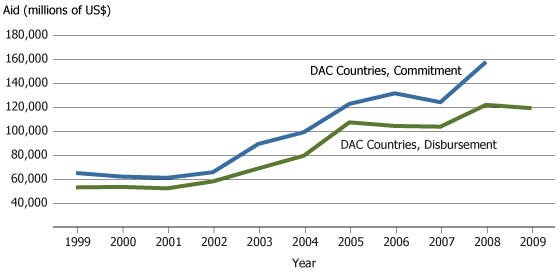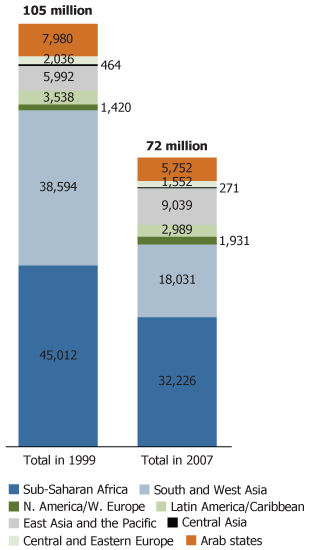
Progress and Setbacks Toward Education For All
(May 2010) A lack of basic education in childhood is linked poorer health, fewer job opportunities, and decreased political participation later in life. The major factor inhibiting universal education is the lack of financing in developing countries, according to UNESCO’s 2010 Education For All (EFA) Global Monitoring Report. According to the report, many of the world’s poorest countries are not on track to meet EFA objectives by 2015. Progress toward the Dakar Framework for Action, a comprehensive document on global education goals adopted in 2000, has eroded in developing countries in recent years. Revenue shortages and the reduced level of aid from high-income countries during the global financial crisis have been difficult on developing countries. Although aid started to rise again in 2008, the cumulative shortfall in financing is substantial and threatens the advancements made in the last 10 years toward important education targets. If current trends continue, the world will not meet its global education goals by 2015.
Progress Toward Goals, But Challenges Remain
The original framework has led to important progress in several areas. Today, 33 million fewer children are out of school worldwide than in 1999. If current trends continue, 56 million children will not participate in school in 2015, compared with 72 million in 2007. More girls have an opportunity for basic education: The proportion of girls out of school has declined from 58 percent to 54 percent, and the gender gap in primary education enrollment is narrowing in many countries. Even more encouraging, the number of literate adult females has increased at a faster pace than males.
The EFA report estimates that it would cost an additional $16 billion a year to achieve EFA goals by 2015. This figure represents the financing gap between the resources needed to meet basic education targets and the funds currently available from domestic sources. Planned increases in aid for overall development have not met the levels that the international community committed itself to in 2005, and the global crisis has taken its toll on financial aid packages. In Africa alone, the gap between the $50 billion increase in pledges and actual aid will be $18 billion by 2010.
Figure 1
DAC Official Development Assistance Committment vs. Disbursement

Note: The OECD’s Development Assistance Committee (DAC) is a forum for selected member states to discuss issues surrounding aid, development, and poverty reduction. It describes itself as the “venue and voice” of the world’s major donor countries.
Source: International Development Statistics, “Online Databases on Aid and Other Resource Flows,” accessed at www.oecd.org/dac/stats/idsonline, on May 5, 2010.
The Global Recession Is Hampering Progress in Education
While levels of marginalization are difficult to measure, the Deprivation and Marginalization in Education (DME) index gives quantitative information about hard-to-reach and disadvantaged populations. The DME defines “education poverty” as having less than four years of education and “extreme education poverty” as spending less than two years in school. In 22 developing countries, 30 percent or more of 17-to-22-year-olds are living in education poverty. In 26 developing countries, 20 percent or more of 17-to-22-year-olds have grown up in extreme education poverty.
Figure 2
Out of School Children by Region, 1999 and 2007

Source: UNESCO, 2010 EFA Global Monitoring Report, Statistical Table 5.
The global recession has hampered progress toward EFA goals. On the individual level, millions of additional adults and children are at risk of poverty and malnutrition in 2010 compared with a year earlier, according to the United Nations Development Programme’s Human Development Indicators. Falling incomes force many households to cut back on expenses, and parents are unable to send their children to school or buy necessary supplies. At the national level, developing countries are making sharp cuts in education budgets as they face declining revenues, high deficits, and slower growth over the next several years. In sub-Saharan Africa, the potential loss of financing for education will average around $4.6 billion annually in 2009 and 2010. On the international level, some countries and regions stand to lose out as slower progress in education leads to sluggish economic growth, unemployment, deteriorating public health, and marginalization in the increasingly knowledge-based global economy.
Education levels are lowest in the poorest countries; however, factors other than wealth can affect access to basic education. Females, ethnic minorities, children living in remote rural areas, and poor families face a higher chance of educational marginalization. Of the 759 million adults and youths lacking literacy skills today, two-thirds are women, an alarming figure since literacy can act as a tool for skills development and a way out of poverty. Children with disabilities are frequently stigmatized because of negative social attitudes, and a lack of teacher training or resources limit their quality of learning. Conflict areas also experience lower levels of education because of population displacement and post-traumatic stress associated with violence. Undereducated youth in conflict areas are often overlooked: One-third of children out of school come from conflict areas, yet less than one-fifth of the aid to education reaches them. These factors can create a cruel cycle of low education, discrimination, poverty, and fewer opportunities to break out of this self-reinforcing loop.
Meeting the goal of universal education starts with adequate nutrition, improved access to health care, and effective early childhood education. These factors can reduce the effects of social disadvantages and serve as a foundation for continued learning. Today, millions of children face learning disabilities and mental impairment since birth as a result of inadequate health care in developing countries, while improved medical services can prevent many of these problems. Regrettably, the ones able to benefit the most from early childhood care have the least access to it because they are usually the poorest in society.
What Can the International Community Do?
The report notes that three policy changes are needed to reach the goals of EFA. First, addressing the education gap starts with improving affordability and accessibility. This includes lowering school fees, and providing allowances or subsidies to poor families so they can afford supplies, books, and uniforms. In addition, expanding the network of schools in order to reach children in more remote areas is vital. Second, the quality of education needs to improve. Data from South and West Asia, as well as sub-Saharan Africa indicate that a large number of children do not reach a minimum level of literacy and numeral skills, even when they finish their primary education. Even worse, many drop out of school before completing their full primary education. These trends can change with the help of more adequate learning facilities and more qualified teachers. Finally, government regulation should provide a catalyst for change. Local governments can redistribute funding to poorer areas to close the gap between the most and least privileged parts of society, as has been done in Brazil. Legal avenues can also offer support to ending discrimination. The Roma in Europe, for example, successfully used legal means to overcome institutionalized segregation. Much work still must be done in order to meet education goals, but the last decade has shown that a global commitment and focus on an issue produces positive results.
Kata Fustos is an intern in the Communications department at the Population Reference Bureau.
References
- UNESCO, World Education Forum Final Report (Paris: UNESCO, 2000).
- UNESCO, EFA Global Monitoring Report – Reaching the Marginalized (Paris/Oxford: UNESCO /Oxford University Press, 2010).
- International Development Statistics, Online Databases on Aid and Other Resource Flows (Paris: Organisation for Economic Co-operation and Development, 2009).
